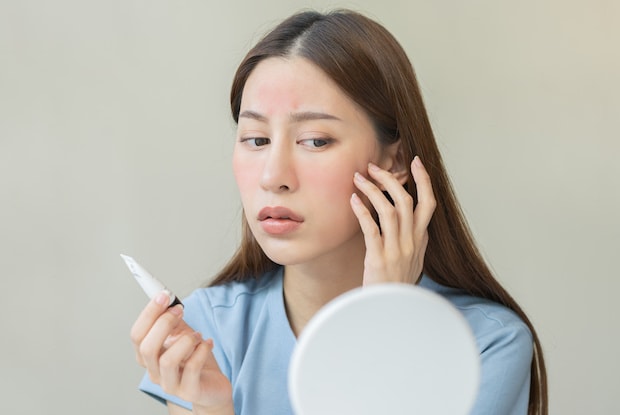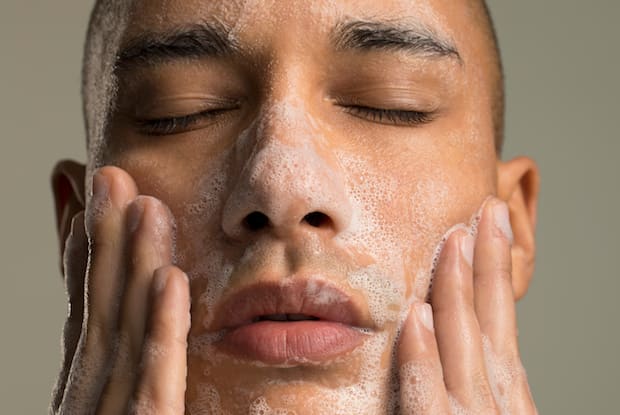Table of Contents
V. How to diagnose skin of color
Difficulty in diagnosis
Rosacea is a skin condition that affects millions of people around the world. Rosacea comes with several symptoms but presents itself with visible blood vessels under the skin, which causes redness. Rosacea is most commonly diagnosed in those with a pale complexion, but people of any skin tone can have this condition.
Dermatologists sometimes have trouble diagnosing rosacea in those with darker skin tones. People of color may be experiencing symptoms of rosacea and remain undiagnosed. These patients often have to deal with rosacea symptoms without proper medications, like Azelex, or diagnosis. Redness may be easier to see in paler patients, but anyone can get this condition. [1]

a. Misdiagnosis
People of color can have trouble getting properly diagnosed because their symptoms may be mistaken for a different skin disorder. Some conditions may be misdiagnosed as rosacea and vice versa. These conditions can include:
Acne vulgaris: The initial onset of acne vulgaris typically occurs in adolescence and results in pustules and papules on the face and upper trunk.
Steroid acne: This type of acne can occur when a patient uses steroid-containing topical agents.
Seborrheic dermatitis: This involves skin inflammation that occurs near the nose, ears, and eyebrows.
Contact dermatitis: This occurs when your skin is exposed to a chemical or allergen that can cause itchy and scaly skin.
Perioificial dermatitis: This type usually occurs in young women and involves pustules near the mouth, nose, and eyes.
Keratosis pilaris rubra: This is a harmless condition that causes rough patches and tiny bumps on the upper arms, thighs, cheeks, and buttocks.
Dermatomyositis: This type involves a red or purplish rash that manifests on the eyelids, knuckles, or fingers. Red papules in specific patterns on the body also occur.
Symptoms of rosacea
The symptoms of rosacea are relatively the same for every patient, but skin tone can make some signs harder to identify than others. The symptoms of rosacea include:
- Flushing and burning of the face in the central face
- Redness (erythema) of the face, when it can be seen
- Redness of the eyes, swollen eyelids
- Increased oiliness
- Bumps or pimples on the face
- Thickened skin on the nose (rhinophyma)
For people of color, the redness of the face may be hard to detect. For example, African-Americans with rosacea may have a more violet tone to their rosacea than traditional redness. When a person has richly pigmented skin, the redness can be masked. [2]
Rosacea worldwide
In a 1993-2010 US National Ambulatory Medical Care Survey on the racial distribution of rosacea, it was found that a notable amount of patients with a darker skin tone were affected. This study showed that 2% of rosacea patients were black, 2.3% Asian or Pacific Islander, and 3.9% Hispanic or Latino.

Over the years, the prevalence of rosacea in people of color has varied. The majority of epidemiologic reports tend to focus on rosacea as a disease of fair-skinned people of northern European descent. These reports have skewed the perception of this disease, making it seem like only Caucasian people experience rosacea.
This perception continues to be a problem because it leads to misdiagnoses in people of color. If there is a delay in diagnosis, then the following conditions may occur:
- Loss of sight in the case of ocular rosacea
- Disfigurement from rhinophyma
- Greater risk of morbidity
- Risk of skin infection
- Dry, painful skin
Triggers
In many cases, rosacea is caused by genetic factors, but environmental factors also affect rosacea. Studies also suggest that the blood vessel structure and function of white patients, Afro-Caribbean, Korean, and Southeast Asian patients have lower vascular endothelial (cells that line the surface of blood vessels) function. This factor may contribute to a risk for rosacea, but skin color does not change the risk factor of rosacea overall. [3]
The most common causes of rosacea include:
- Food and beverages: hot drinks, caffeinated beverages, alcohol, spicy food
- Sun exposure
- Temperature extremes
- Intense exercise
- Stress
- Medications
- Cosmetic products: Some cosmetic products can be abrasive or aggravate rosacea symptoms [4]
Geographic factors and regional skincare products can also be triggering factors. Some patients with darker skin tone may use skin lighteners of brighteners, shea butter or coconut butter (occlusive moisturizers), or astringent or abrasive skin products. The properties in these products can sometimes increase the likelihood of rosacea. If you live in a place with lots of sun exposure and a high UV index, then your chances of rosacea may be more likely.
How to diagnose skin of color
There are several ways to diagnosis this condition if a person with darker skin suspects that they have rosacea. Some of these tests may include:
Skin tests: A doctor may test for skin blanching by using a magnifying glass or slide that can help visualize redness. If the skin pales when pressed on the glass or slide, then erythema (redness of the skin or mucous membrane) is present and signifies rosacea.
Photograph: A dermatologist can photograph the patient on a dark blue background, which can make the redness on the skin more visible.
Dermatoscope: This instrument helps detect lesions on the skin through skin surface reflections. This can help differentiate the pigment of the skin versus the blood vessels.
Presence of papules and pustules: Papules and pustules will be present without comedones (whiteheads/blackheads), which differentiates rosacea from acne.
Ocular symptoms: The eyes may burn and itch if affected by rosacea. The thickening of the nasal and cheek skin may signal rosacea.

Treatment
The treatment of rosacea in those with darker skin is the same for those with paler complexions. Once a proper diagnosis occurs, traditional rosacea treatments can be prescribed. Rosacea does not improve by itself and worsens over time, so adequate prescription treatment is recommended.
a. Topical medications
Gels and lotions like azelaic acid (Azelex) and Metrogel are conventional treatments. Azelex helps reduce the creation of new pimples and eliminate bacteria. Metrogel is a little different and is often used to fight bacterial infections that may occur due to the pustules created by rosacea.
b. Oral medications
Antibiotics like tetracycline and minocycline are anti-inflammatories used to treat milder forms of rosacea.
c. Laser therapy
Laser therapy uses light energy to treat visible blood vessels to reduce redness. Laser resurfacing may also reduce the tissue overgrowth that comes with rhinophyma.
Recommended skincare
Once rosacea is appropriately diagnosed, the dermatologist can advise patients of color on a proper skincare routine. Everyone’s routine may look different, but some products are better than others for rosacea. Some recommended products can include:
- Once-daily Non-alkaline, fragrance-free cleansers
- Silicone-based moisturizers
- Light, water-based cosmetics
- Physical sunblock (zinc oxide)
Everybody reacts differently to various skin products, but it is generally advised to avoid the following products:
- Alcohol-based cleansers, astringents, or abrasive exfoliating cleansers
- Chemical sunscreens
- Cosmetics with iridescent (sparkly, shiny) effects
- Non-silicone based moisturizers [4]
The content in this article is intended for informational purposes only. This website does not provide medical advice. In all circumstances, you should always seek the advice of your physician and/or other qualified health professionals(s) for drug, medical condition, or treatment advice. The content provided on this website is not a substitute for professional medical advice, diagnosis or treatment.
